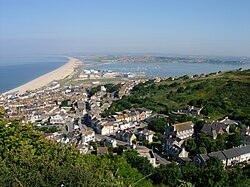Chesil Beach | |
|---|---|
 Chesil Beach viewed from the Isle of Portland | |
| Coordinates: 50°36′14″N 2°30′58″W / 50.604°N 2.516°W | |
| Grid position | SY635784 |
| Location | Dorset, England |
| Official name | Chesil Beach & The Fleet |
| Designated | 17 July 1985 |
| Reference no. | 300[1] |
Chesil Beach (also known as Chesil Bank) in Dorset, England is one of three major shingle beach structures in Britain.[2] Its name is derived from the word chessil (Old English ceosel or cisel), meaning "gravel" or "shingle". It runs for a length of 29 kilometres (18 mi) from West Bay to the Isle of Portland and in places is up to 15 metres (50 ft) high and 200 metres (660 ft) wide. Behind the beach is the Fleet, a shallow tidal lagoon. Both are part of the Jurassic Coast and a UNESCO World Heritage Site, and together form an SSSI and Ramsar Site. Owners of the land designated as Chesil & The Fleet SSSI[3] include the Crown Estate, the Ministry of Defence and the National Trust.[4]
The beach is often identified as a tombolo, although research into the geomorphology of the area has revealed that it is in fact a barrier beach which has "rolled" landwards, joining the mainland with the Isle of Portland and giving the appearance of a tombolo.[5][6]
The beach curves sharply at the eastern end, near the village of Chiswell, and forms Chesil Cove against the cliffs of the Isle of Portland, and this protects the low-lying village from flooding. It has been the scene of many shipwrecks and was named "Dead Man's Bay" by Thomas Hardy. The beach provides shelter from the prevailing winds and waves for the town of Weymouth, Dorset and the village of Chiswell on Portland.
Simon Jenkins rates the view of Chesil Beach from Abbotsbury along the coast to Portland Bill as one of the top ten in England.[7]
- ^ "Chesil Beach & The Fleet". Ramsar Sites Information Service. Retrieved 25 April 2018.
- ^ A. P. Carr and M. W. L. Blackley, "Investigations Bearing on the Age and Development of Chesil Beach, Dorset, and the Associated Area" Transactions of the Institute of British Geographers, No. 58 (March 1973) pp. 99-111.
- ^ "SSSI detail". designatedsites.naturalengland.org.uk. Retrieved 29 September 2024.
- ^ "Mapping the habitats of England's ten largest institutional landowners". Who owns England?. 6 October 2020. Retrieved 29 September 2024.
- ^ [1] Archived 31 December 2009 at the Wayback Machine
- ^ Goudie, Andrew (1990). The Landforms of England and Wales. Oxford: Basil Blackwell Ltd. p. 264. ISBN 0631173064.
- ^ "Our glorious land in peril". The Telegraph. 28 September 2013.
